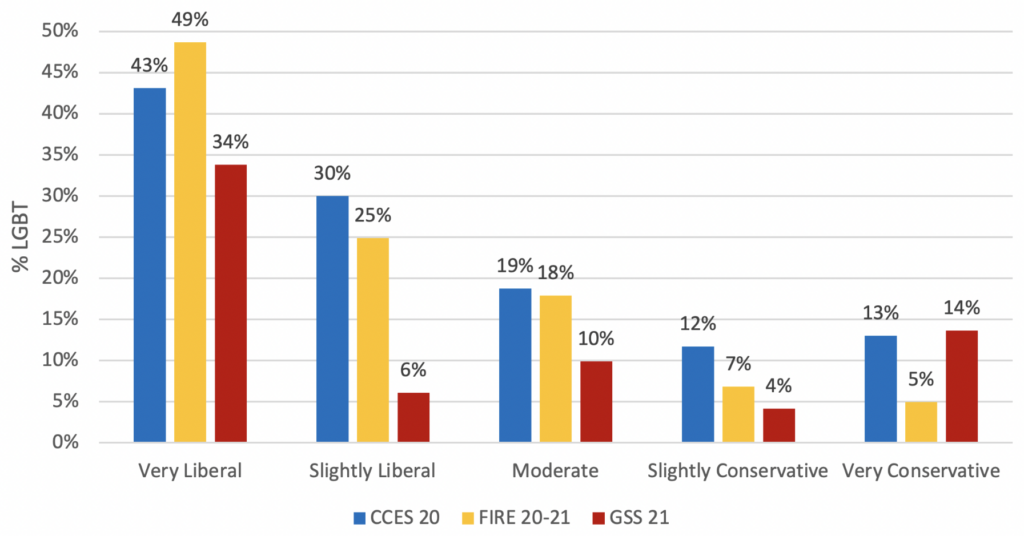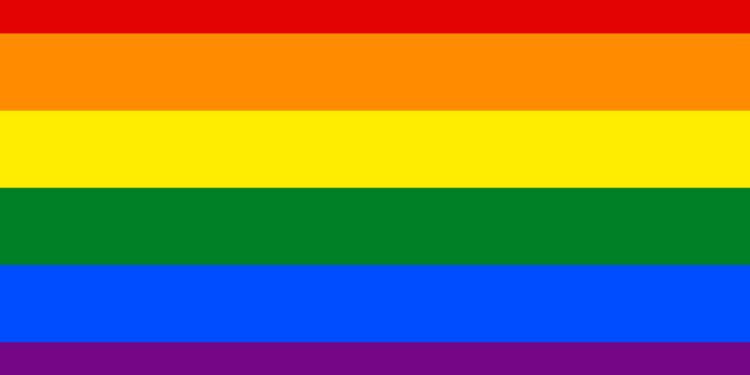The instantly recognizeable ‘LGBT flag’ seem to be everywhere nowadays. It’s printed on National Trust badges; it’s flown outside U.S. embassies; and it’s painted on the side of police cars. Mega-corporations emblazon their logos with the flag every June, which comprises ‘LGBT pride month’ (though their Middle East divisions are notably exempt from this trend).
Has the rainbow-isation of everything been accompanied by an increase in LGBT identity – in people identifying as a sexual minority? It has, according to a comprehensive new study by political scientist Eric Kaufmann. Focussing on the U.S. (where there’s an abundance of relevant data) he finds that society is becoming less ‘straight’.
Unsurprisingly, the rise in LGBT identity is concentrated among young people. Depending on which dataset you look at, between 16 and 25% of under 30s now identify as something other than ‘heterosexual’. The true figure is likely toward the lower end of these estimates, says Kaufmann. Even so, this would still mean that one in every six young Americans has an LGBT identity.
Okay, so a lot of people say they’re not straight. But is this reflected in their actual behaviour? In part, yes. But Kaufmann finds that rising LGBT behaviour accounts for less than half the rise in LGBT identity. As the chart below indicates, non-heterosexual identity is up by 11 percentage points since 2008, whereas non-heterosexual behaviour (reporting at least one same-sex partner in the past year) is only up by 4 percentage points.

What explains the disparity between identity and behaviour? There’s now a large segment of women who identify as ‘bisexual’ despite having only male sex partners. In 2018–21, 55% of ‘bisexual’ women under 30 had only male sex partners, compared to just 13% in 2008–10. A similar trend was evident among ‘bisexual’ men, though it was much less pronounced.
Note: part of the rise in non-heterosexual behaviour may reflect higher rates of reporting now there’s less stigma. And while this would imply that figures for earlier years are underestimates, it couldn’t explain the growing gap between identity and behaviour.
Turning to politics, Kaufmann finds that LGBT identity is heavily concentrated among those with ‘very liberal’ views. As the chart below indicates, between 34 and 49% of under 30s with such views – compared to less than 15% among conservatives.

Of course, one would expect non-heterosexuals to gravitate away from conservatism, with its emphasis on the traditional family. But notice that the percentages for moderates are only slightly higher than for conservatives. This suggests the pattern can’t simply be explained by non-heterosexuals embracing ideologies that are more tolerant of their lifestyles.
Zooming-in on college students, Kaufmann finds dramatic differences by subject area. Those studying the social sciences or humanities are about 10 percentage points more likely to identify as LGBT than those studying the hard sciences. And among those taking “highly political majors” like gender and race studies, the LGBT share reaches 50%!
All this suggests the LGBT phenomenon represents a kind of fashion on the political left. It’s now possible to raise one’s status (either as a ‘victim’ or ‘non-conformist’) by claiming to be ‘LGBT’ – even if one’s behaviour is strictly heterosexual. Of course, fashions have a habit of changing, and it remains to be seen how long this one will last.












To join in with the discussion please make a donation to The Daily Sceptic.
Profanity and abuse will be removed and may lead to a permanent ban.
Monstrous 5G Towers
Monstrous 5G
They are everywhere ! Are they switched on yet ( Phone Mast , do me a favour ) !!
) !!
Have the reports of risks from 5G been adequately assessed yet.
I’m confident they’ll get the “safe and effective” stamp of approval. Oh, and “necessary”, of course. We all know just how necessary these damned things are..

https://www.hartgroup.org/define-safe/
Safe and effective, of course.
And mandatory. Sooner or later.
https://www.hartgroup.org/define-safe/
No, no time – the technology is new, but there are 8 recent case studies in real life conditions. They are summed up here and context is given (i.e. past wireless radiation wasn’t safe and 30 years worth of studies show this): https://dailysceptic.org/2024/02/26/are-we-taking-the-risks-of-5g-seriously-enough/
‘Consultation with local community required’… So did they do this?
Why do we keep letting these people do what they damn well feel like?, if I was a resident I would be complaining to the council, 3, the papers, tv and anyone I could think of, hardly “enviromentally” friendly is it.
And you can bet that the people who approved the tower live far, far away.
There is a chance to object to planning policy via the NPPF consultation by 24th Sep. Send an email saying you support the submission here: https://rfinfo.co.uk/nppf-consultation/ Though they are not consulting on telecoms, they are consulting on Public Sector Equality Duty. People with implants are not protected and those with electromagnetic hypersensitivity need help urgently. There are many people in these 2 categories.
Strange that so few people realise that these masts will cause health problems. Prof Lennart Hardell recently did 8 5G case studies in real-life conditions showing that people get pretty bad symptoms. DS printed a summary of these studies.
No councillors living in THAT village then.